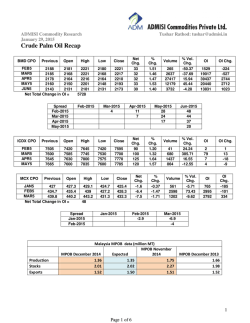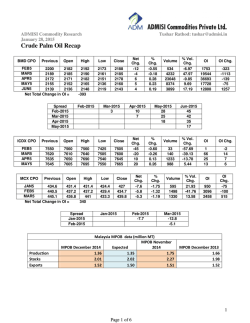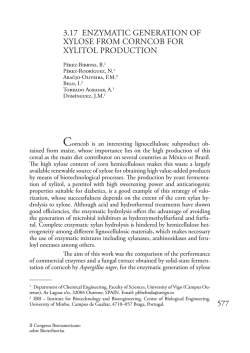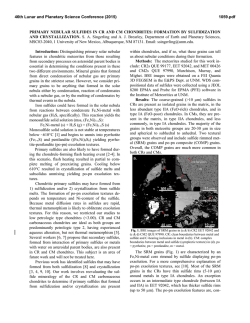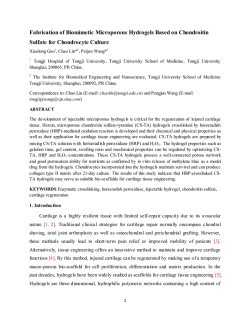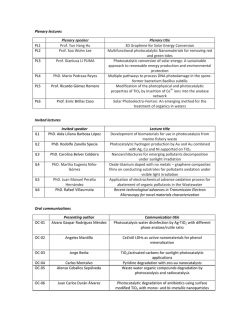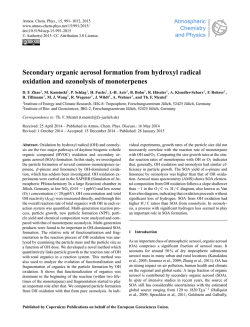
Download - ResearchGate
Journal of Molecular Catalysis A: Chemical 204–205 (2003) 391–400 Selectivity in the peroxidase catalyzed oxidation of phenolic sulfides Antonio De Riso a , Michele Gullotti a , Luigi Casella b,∗ , Enrico Monzani b , Antonella Profumo b , Luca Gianelli c , Luca De Gioia d , Noura Gaiji d , Stefano Colonna e a Dipartimento di Chimica Inorganica e Metallorganica, Centro CNR, Università di Milano, 20133 Milano, Italy b Dipartimento di Chimica Generale, Università di Pavia, Via Taramelli 12, 27100 Pavia, Italy c Centro Grandi Strumenti, Università di Pavia, 27100 Pavia, Italy d Dipartimento di Biotecnologie e Bioscienze, Università di Milano-Bicocca, 20126 Milano, Italy e Instituto di Chimica Organica, Facoltà di Farmacia, Università di Milano, 20133 Milano, Italy Received 17 September 2002; received in revised form 16 January 2003; accepted 25 January 2003 Dedicated to Professor Renato Ugo on the occasion of his 65th birthday Abstract The catalytic oxidation of ortho- and para-alkylthiophenols, carrying methyl or ethyl substituents at sulfur, by lactoperoxidase (LPO), horseradish peroxidase (HRP) or chloroperoxidase (CPO), in the presence of hydrogen peroxide, has been investigated. HRP and CPO are active toward these substrates, whereas LPO is only active with the ortho-substituted compounds. The enzymatic solutions containing ortho-alkylthiophenols develop an intense blue color (with optical absorptions near 400 and 600 nm) that is attributed to the formation of relatively stable dimeric three-electron bonded complexes resulting from the association of enzyme-derived radical cations with the phenolic sulfide. The products of the enzymatic reactions by HRP and LPO are oligomers resulting from phenol oxidative coupling reactions and the sulfoxide, with minor amounts of oligomers containing mono or disulfoxide functionalities. With CPO the major product is always the sulfoxide, while phenol coupling products are formed in minor amounts. The selectivity exhibited by LPO toward 2- and 4-methylthiophenol has been investigated through binding experiments, NMR relaxation measurements of LPO-substrate complexes and docking calculations. The para-isomer binds much more strongly than the ortho-isomer to the enzymes. The stronger binding depends on the establishment of hydrogen bonding interactions with protein residues in the active site. © 2003 Elsevier Science B.V. All rights reserved. Keywords: Peroxidase; Alkylthiophenols; Hydrogen peroxide; Paramagnetic NMR relaxation; Docking calculations 1. Introduction ∗ Corresponding author. Tel.: +39-0382-507-331; fax: +39-0382-528-544. E-mail address: [email protected] (L. Casella). Peroxidases are widely distributed heme proteins catalyzing a variety of oxidative transformations on organic and inorganic substrates by hydrogen peroxide or alkyl peroxides [1–3]. Typically, the catalytic 1381-1169/$ – see front matter © 2003 Elsevier Science B.V. All rights reserved. doi:10.1016/S1381-1169(03)00321-2 392 A. De Riso et al. / Journal of Molecular Catalysis A: Chemical 204–205 (2003) 391–400 cycle of these enzymes involve one-electron oxidation of two substrate molecules by the enzyme catalytic intermediates indicated as compound I and compound II [2]. Compound I is an iron(IV)-oxo species carrying a porphyrin or protein radical, which is formed by two-electron oxidation of the enzyme by the peroxide, while compound II is an iron(IV)-oxo species, one oxidative equivalent above the enzyme resting state. Among the various substrates, phenols and anilines have been particularly useful as mechanistic probes [1,4,5] and as polymers precursors [6,7] in peroxidase catalyzed reactions. In our previous studies we showed that substituted phenols are also good structural probes for peroxidases [8–10], since the properties of these substrates can be modulated through changes in the nature of the substituent. Apparently, very little is known on the behavior of peroxidases toward substrates carrying two functions which can potentially act as centers of enzymatic reactions [3]. Our interest, therefore, focused on the catalytic behavior of peroxidases toward a group of phenolic sulfides (Scheme 1) to the end of investigating the regio- and stereoselectivity effects involved in the enzymatic reactions. These substrates were chosen because the sulfide function is known to undergo oxidation, producing sulfoxides, by peroxidases in the presence of hydrogen peroxide [3,11–13]. The enzymatic oxidation of the ortho- and para-alkylthiophenols 2-mtp, 4-mtp, 2-etp and 4-etp was studied using three peroxidases: horseradish peroxidase (HRP), lactoperoxidase (LPO) and chloroperoxidase (CPO). The X-ray crystal structures of HRP [14] and CPO [15] are known, while the overall features of the LPO structure have been proposed [16] to be similar to those shown by the X-ray structure of myeloperoxidase [17]. 2. Experimental HRP (mostly isoenzyme C) was purchased from Sigma as a freeze-dried powder (type VI-A, RZ 3.2 at pH 7.0). CPO was also purchased from Sigma as a suspension in 0.1 M sodium phosphate, pH 4, and purified as described previously [9]. Bovine LPO (RZ 0.90) was purified from milk following a literature procedure [18]. The concentration of HRP, LPO and CPO solutions was determined optically using ε402 = 102 mM−1 cm−1 for HRP, ε412 = 112 mM−1 cm−1 for LPO, and ε403 = 91 mM−1 cm−1 for CPO. All enzyme solutions were prepared using double distilled water. Hydrogen peroxide solutions were prepared by dilution of a 30% solution and standardized by titrimetry. The phenolic sulfides 2-mtp and 2-etp were commercial products from Lancaster and Aldrich, respectively. The 4-mtp and 4-etp derivatives were prepared under an inert atmosphere by reaction of the corresponding 4-hydroxyphenyl thiolates with the appropriate alkyl halides in ethanol as solvent, according to the procedure described in literature [19]. 2.1. Enzymatic oxidation of phenolic sulfides The phenolic sulfide (0.2 mmol) and the enzyme (4×10−7 mmol) were magnetically stirred in 200 mM acetate buffer solution, pH 5.0 (20 ml) at room temperature, for a few minutes. The reaction was started by the addition of H2 O2 (0.2 mmol). After 1 min the reaction was quenched with sodium sulfite. Extraction with two portions (20 ml each) of diethyl ether and one portion (20 ml) of methylene chloride, followed by drying with Na2 SO4 , and evaporation of the organic solvents, gave the crude mixture of products. The product mixtures solubilized in CHCl3 were then analyzed by HPLC and MS as described below. Scheme 1. A. De Riso et al. / Journal of Molecular Catalysis A: Chemical 204–205 (2003) 391–400 A C18 LiChorCART Superspher (Merck) column was equilibrated in 50% solvent A, consisting of 0.1% CH3 COOH in water, and 50% solvent B, consisting of CH3 OH. Each sample (20 l) was injected into the column, and after 2 min elution with the same solvent mixture as above, a 50–95% gradient of B was applied over 8 min, followed by a 95–100% gradient of B over 9 min, and 100% B for 7 min, at a flow rate of 1 ml/min. The HPLC pump used in these experiments was a Spectra System P4000 and the UV-Vis detector a Spectra System UV2000. A Finnigan LCQ Ion Trap mass spectrometer (ThermoFinnigan, San Jose, CA, USA) was coupled on-line with the HPLC system in order to analyze the eluted mixtures of compounds; each sample was introduced into the MS instrument directly from the HPLC using an atmospheric pressure chemical ionization (APCI) ion source. The APCI source operated at 3.3 kV, the capillary temperature was set at 200 ◦ C and its voltage at 10 V; the experiments were performed in positive ion mode. Flow injection analysis of the product mixtures infused directly into the MS instrument were carried out to calculate the relative percentage distribution; the same experimental condition were used as in the HPLC–MS analysis. The monitored ions were the proton adducts of the compounds, [M + H]+ . 2.2. Binding studies Binding constants of 2-mtp and 4-mtp to the peroxidases were determined by optical titration at 20 ◦ C on solutions of the enzymes (about 5 M) in 200 mM acetate buffer containing 10% ethanol (v/v), by adding concentrate solutions of the sulfides in the same solvent, following procedures reported previously [8,9] for determination of the dissociation constants (Kd ). 2.3. Differential pulse voltammetry Polarographic measurements were performed at room temperature on an Amel mod.591/ST Polarograph coupled with an Amel 433 Trace Analyzer, equipped with a conventional three electrode cell (glassy carbon as working electrode, Ag/AgCl/KCl (3.5 M) (+204 mV versus NHE) reference electrode and platinum auxiliary electrode) in 200 mM acetate buffer, pH 5.0, using a scan rate of 100 mV/s, a pulse amplitude of 50 mV, Ei = 200 mV. The values of 393 redox potential measured polarographically correspond to the transformation of the phenols into the corresponding phenoxy radicals. Voltammetric oxidation of phenols causes passivation of the electrode surface that results in a rapidly diminishing voltammetric curve response and broadening of the peaks. In the presence of cetyl trimethylammonium chloride (CTA), passivation of the electrode is reduced because it protects the surface of the electrode. For this reason, the absolute values of the oxidation potential of the compounds investigated may be affected by the experimental conditions (electrode surface, pH, and concentration of the solution). However, the difference among the values of the oxidation potentials found for the various substrates are significant because they were obtained exactly in the same experimental conditions. 2.4. Relaxation time measurements Longitudinal relaxation time (T1 ) measurements of substrate protons at various enzyme–substrate molar ratios were carried out at 400 MHz on a Bruker AC 400 spectrometer at 27 ◦ C, following procedures described previously [20]. The τ c values necessary for deducing iron–proton distances from relaxation rate data were 9.5 × 10−11 , 4.5 × 10−10 , and 8.8 × 10−11 s for HRP [21], LPO [21], and CPO [9], respectively. 2.5. Docking calculations The X-ray structure of HRP was downloaded from the Protein Data Bank (http://www.rcsb.org; code: 2ATJ). The three-dimensional structure of LPO was predicted by homology modeling, according to previously published results [16]. Model structure refinement was carried out by molecular mechanics (MM) calculations, using the Discover software package [22], with an extension of the consistent valence force field previously developed to study hemoproteins [23]. The substrates were modeled using the InsightII program [22] and optimized by MM with the same force field used for proteins. Docking experiments were performed using the program AUTODOCK [24], and its graphical interface was used to assign potentials, charges and solvation parameters. Boxes of 33 and 50 Å3 , centered on the heme iron atom, were used to enclose regions overlapping with the active 394 A. De Riso et al. / Journal of Molecular Catalysis A: Chemical 204–205 (2003) 391–400 site of LPO and HRP, respectively. Grid maps were generated using standard AUTODOCK parameters. The optimizations were carried out using the Genetic Algorithm approach as implemented in AUTODOCK. Population size was set to 50, maximum energy evaluations to 250 000, maximum number of generations to 270 000, maximum number of individuals that automatically survive in the next generation to 1, rate of gene mutation to 0.02 and rate of cross over to 0.8. 3. Results and discussion In the presence of each peroxidase and hydrogen peroxide, solutions of the ortho-substituted compounds 2-mtp and 2-etp develop a blue color corresponding to rather intense visible bands near 400 and 600 nm (Fig. 1). With progress of time some turbidity occurs in the solution, due to precipitation of organic polymeric products, and the color fades. No reaction occurs in the same conditions in the absence of enzyme. The behavior of the para-substituted compounds 4-mtp and 4-etp is different, because with HRP and CPO the enzymatic reaction produces a broad increase of UV absorption in the 300–400 nm range, tailing into the visible region and with no defined optical maximum, prior to polymer precipitation, while LPO appears to be completely unreactive toward these compounds. The intense and persistent blue color developed upon oxidation of 2-mtp and 2-etp is likely associated with generation of unusually stable electron deficient species. The compound I and compound II enzyme intermediates react with simple phenols producing phenoxy radicals (and protons) [2], and with aryl alkyl sulfides producing radical cations [25]. Both these species are short lived and cannot be responsible for the observed blue color. On the other hand, the behavior of the isomeric 4-mtp and 4-etp compounds is different and conforms to the usual spectral pattern observed upon enzymatic oxidation of, e.g. simple phenolic substrates [14]. We believe that the intensely colored species are dimeric three-electron bonded complexes, symbolized as [R2 S∴SR2 ]+ , which are produced by the enzyme-derived sulfur radical cations of the ortho-substituted phenolic sulfides, according to the equilibrium: R2 S•+ + SR2 [R2 S ∴ SR2 ]+ Unusually stable dimeric cation complexes, with optical absorptions in the range 475–500 nm, have been previously characterized in the case of -hydroxyalkyl sulfides [26]. It is therefore expected that the stability of such dimeric cations will be further increased for ortho-phenolic sulfides, where conformationally favorable five-membered, S · · · H–O bonded, structures can be formed, as shown in Scheme 2. The richer and red-shifted electronic spectra observed here result from the extended conjugation with the aromatic nuclei. The presence of two functional groups rises problem of their mutual influence in determining the Fig. 1. Optical absorption spectra recorded in the initial phase of the reaction of 2-etp (0.135 mM) with HRP (70 nM) and H2 O2 (0.3 mM) in 0.2 M acetate buffer pH 5.0. A. De Riso et al. / Journal of Molecular Catalysis A: Chemical 204–205 (2003) 391–400 395 Table 1 Polarographic data for one-electron oxidation of phenolic derivatives Scheme 2. reduction potential of the substrate. Since peroxidases are one-electron oxidants, this parameter is of great importance for an understanding of the enzymatic reactions [10,27]. In the present case, it is essential to understand the origin of the discrimination exerted by LPO toward the 2- and 4-substituted isomeric phenolic sulfides. The polarographically determined redox potential values for 2-mtp, 4-mtp and 2-etp (for the couple phenoxy radical/phenol), together with those of some relevant mono and difunctional aromatic compounds are collected in Table 1. Phenolic sulfides clearly show markedly reduced E◦ values with respect to simple phenols and aromatic sulfides. Both the hydroxyl and sulfide functions contribute to E◦ reduction of the aromatic nucleus, likely because both render it more electron rich. This effect is confirmed by the behavior of 4-(methylthio)-1-methoxybenzene, which shows that also the methoxy substituent lowers the E◦ of the aromatic sulfide. The electrochemical data, therefore, show that phenolic sulfides are more easily oxidized than their parent monofunctional derivatives and, therefore, the discriminating behavior of LPO toward ortho- and para-substituted mtp isomers is Compound E (mV) without CTA E (mV) with CTA Phenol Methyl phenyl sulfide Ethyl phenyl sulfide 2-mtp 2-etp 4-mtp 4-Methylthio-1-methoxybenzene 866 1290 1270 615 640 652 988 831 – – 584 554 600 – not related to difficulties in producing the radical species. In order to identify the polymeric products, HPLC– MS experiments were performed on the organic extracts of the enzymatic reactions. Unfortunately, the product mixtures are complex and a complete separation of the oligomers has been impossible to achieve, preventing to obtain quantitative data. However, MS analysis of the poorly separated peaks in the HPLC chromatograms enabled to unravel the basic composition of the oligomeric products in the experimental conditions employed. The representative data reported in Table 2, although not corresponding to the actual yields of the reactions, serve to illustrate the general trend observed in these experiments: (i) HRP and LPO (with ortho-alkylthiophenols only) are more efficient than CPO in the enzymatic reactions and produce significant amounts of dimeric, trimeric, Table 2 Relative abundance (%) of the MS peaks detected in the HPLC–MS analysis for representative enzymatic oxidations of phenolic sulfidesa Product Monomer sulfoxide Dimer Dimer monosulfoxide Dimer disulfoxide Trimer Trimer monosulfoxide Trimer disulfoxide Tetramer Pentamer Hexamer a 2-mtp 4-mtp 2-etp HRP CPO HRP CPO HRP CPO 1.6 21.8 0.5 – 30.6 1.0 2.6 26.8 4.7 10.4 80.3 12.2 2 – 1.3 – – 2 0.9 0.2 32.5 14.1 1.2 0.9 25.6 1.1 0.8 20.5 1.1 0.2 70.3 8.3 2.3 – 7.6 1.1 0.4 8.2 0.8 0.2 58.9 5.7 1.3 – 9.9 – – 16.7 6.8 – 81.7 4.3 1.8 8.6 1.2 1.2 – – – – In all cases, the peak corresponding to residual unreacted substrate was absent or below 1%. 396 A. De Riso et al. / Journal of Molecular Catalysis A: Chemical 204–205 (2003) 391–400 tetrameric, pentameric and hexameric oligomers resulting from phenol coupling reactions, together with sulfoxide and minor amounts of oligomers containing monosulfoxide and disulfoxide groups; (ii) with CPO the major product is always the sulfoxide, while phenol coupling products are formed in minor amounts. The selectivity observed in the present reactions is clearly related to the mode of substrate interaction in the active site of the enzyme. Though, while the preference of CPO in the oxidation of the sulfide rather than the phenol function is in keeping with the expectation on the basis of the behavior of the enzymes toward the related monofunctional substrates [9–12], the absolute stereoselectivity exhibited by LPO in the oxidation of the ortho- and para-alkylthiophenols is a most unexpected result. We therefore decided to investigate in more detail the interaction of the isomers 2-mtp and 4-mtp with the enzymes to gain an understanding of the origin of these effects. As shown by the data in Table 3, both 2-mtp and 4-mtp bind to the enzymes, and it is interesting that in the case of LPO the unreactive compound 4-mtp binds much more strongly than the 2-mtp isomer. Also HRP exhibits a preference for 4-mtp, whereas Table 3 Dissociation constants (Kd , mM) of peroxidase complexes with the donors 2-mtp and 4-mtp, in acetate buffer pH 5.0–ethanol 10% (v/v) Donor LPO HRP CPO 2-mtp 4-mtp 35.8 0.7 16.2 1.7 3.9 4.2 for CPO the two isomers have similar affinity. The iron–proton distances deduced from NMR relaxation measurements for bound mtp molecules in the enzyme–donor complexes show significantly different behavior for 2-mtp and 4-mtp only with CPO. The para-isomer can apparently approach the iron center of this enzyme closely from the distal side, with rather short Fe–H distances of 5.0–5.1 Å, in a manner similar to that found previously for CPO-p-cresol and similar complexes [9]. The very similar distances observed for the protons of bound 4-mtp probably depend on the fact that the molecule can enter the enzyme cavity from both substituents sides. For the CPO-2-mtp complex, the iron–proton distances are in the range of 6.7–7.4 Å and are similar to those found for the mtp complexes with HRP and LPO; probably, Table 4 Iron–proton distances (Å) for LPO-2-mtp and LPO-4-mtp complexes from NMR relaxation measurements and docking calculations Proton NMR relaxation Docking position 1 Docking position 2 4.9 6.5 5.8 6.8 7.0 6.6 8.8 10.2 9.7 7.3 5.6 7.0 9.3 10.2 8.7 6.4 7.0 7.9 5.7/10.0 7.5/8.8 9.2 6.4/10.0 5.7/9.6 9.5 LPO-2-mtp 1 2 3 4 5 LPO-4-mtp 1a 2a 3 a While the NMR derived iron–proton distances give only one value, the computational simulation can distinguish between the two protons and provides two distances. A. De Riso et al. / Journal of Molecular Catalysis A: Chemical 204–205 (2003) 391–400 the steric hindrance of ortho-substitution prevents the access to the distal cavity of CPO. The iron–proton distances found for HRP-mtp and LPO-mtp complexes are collected in Tables 4 and 5, where they are compared with the results of docking calculations. In general, the distances obtained from NMR relaxation are shorter than the computed distances, but the accuracy of both approaches is of course limited. The data from relaxation measurements are subject to uncertainty in the τ c values employed, even though the Fe–H distances reported here compare with those found for other HRP and LPO complexes with organic donor molecules [8,9,12,28]. On the other hand, computational procedures cannot take into account slight conformational rearrangements occurring in the active site on binding the donor ligand. In any case, both the approaches demonstrate that the lack of reactivity of 4-mtp with LPO is not due to its binding in a location far from the heme, as it might have been anticipated. Two almost isoenergetic orientations of 2-mtp were found studying its docking to the LPO active site. 397 The substrate extensively interacts with hydrophobic amino acids forming the active site entrance channel (Fig. 2A), but no hydrogen bond with the protein is observed. By contrast, structural analysis of the adduct formed by 4-mtp and LPO reveals that the oxygen atom of 4-mtp is involved in a hydrogen bond with Arg465 (Fig. 2B). Moreover, several hydrophobic interactions between the substrate and phenylalanine residues forming the active site are observed. In this case, the computed iron–proton distances are in good agreement with the NMR measurements (Table 4). Thus, this analysis clearly accounts for the stronger binding to LPO exhibited by the 4-mtp isomer. Its lack of reactivity in the enzymatic reaction may possibly depend on the fact that the hydrogen bond between the OH group and Arg465 prevents 4-mtp from assuming the correct disposition for electron transfer to the heme and the proton dissociation required by phenoxy radical formation. The docking investigation of 2-mtp and 4-mtp to HRP gave similar results (Fig. 3), even if for 4-mtp Table 5 Iron–proton distances (Å) for HRP-2-mtp and HRP-4-mtp complexes from NMR relaxation measurements and docking calculations Proton NMR relaxation Docking position 1 Docking position 2 7.1 7.3 7.7 7.3 7.3 11.0 11.7 13.6 14.7 15.9 10.9 9.9 11.7 14.1 15.9 7.6 7.6 7.6 10.5/15.3 12.3/13.8 14.7 12.4/14.3 11.2/13.7 12.3 HRP-2-mtp 1 2 3 4 5 HRP-4-mtp 1a 2a 3 a While the NMR derived iron–proton distances give only one value, the computational simulation can distinguish between the two protons and provides two distances. 398 A. De Riso et al. / Journal of Molecular Catalysis A: Chemical 204–205 (2003) 391–400 Fig. 2. Best orientations of 2-mtp (A) and 4-mtp (B) in the active site of LPO, as derived by computational simulation. For the sake of clarity, only the heme group, the substrate, and key amino acid residues are explicitly shown. two isoenergetic orientations were predicted (P1 and P2 in Fig. 3B). In P1 the substrate forms a hydrogen bond with Gly69 and interacts with Phe179, whereas in P2 no hydrogen bond is formed. The former disposition would account for the stronger interaction found for 4-mtp to HRP through the binding data. It is noteworthy that iron–proton distances computed for HRP adducts are longer than those obtained investigating LPO (Tables 4 and 5), which qualitative agrees with the NMR results. The structural analysis shows that, in fact, the crevice defining the active site of HRP is narrower than in LPO. In conclusion, the present investigation has shown that the peroxidase catalyzed oxidation of phenolic sulfides occurs with various types of selectivity. CPO exhibits functional group selectivity, addressing the oxidation toward the sulfide rather than the phenolic portion of the substrates. LPO is strictly selective toward the ortho-alkylthiophenols; the lack of reactivity of the para-isomers is related to improductive binding, A. De Riso et al. / Journal of Molecular Catalysis A: Chemical 204–205 (2003) 391–400 399 Fig. 3. Best orientations of 2-mtp (A) and 4-mtp (B) in the active site of HRP, as derived by computational simulation. For the sake of clarity, only the heme group, the substrate, and key amino acid residues are explicitly shown. possibly because this involves an unsuitable disposition of the substrate. To our knowledge this striking regioselectivity effect is unprecedented in peroxidase catalyzed reactions and should be further explored for applicative biotransformations [3,29]. Acknowledgements The authors thank the Italian MURST, through the PRIN, and the University of Pavia, through FAR, for support. 400 A. De Riso et al. / Journal of Molecular Catalysis A: Chemical 204–205 (2003) 391–400 References [1] J. Everse, K.E. Everse, M.B. Grisham (Eds.), Peroxidases in Chemistry and Biology, vols. I/II, CRC Press, Boca Raton, FL, 1991. [2] H. Anni, T. Yonetani, Met. Ions Biol. Syst. 28 (1992) 219. [3] M.P.J. van Deurzen, F. van Rantwijk, R.A. Sheldon, Tetrahedron 53 (1997) 13183. [4] J. Sakurada, S. Takahashi, T. Shimuzu, M. Hatano, S. Nakamura, T. Hosoya, Biochemistry 29 (1990) 4093. [5] A.M. Lambeir, H.B. Dunford, M.A. Pickard, Eur. J. Biochem. 163 (1987) 123. [6] S. Kobayashi, S. Shoda, H. Uyama, Adv. Polym. Sci. 121 (1995) 1. [7] R.A. Gross, A. Kumar, B. Kalra, Chem. Rev. 101 (2001) 2097. [8] L. Casella, M. Gullotti, S. Poli, M. Bonfà, R.P. Ferrari, A. Marchesini, Biochem. J. 279 (1991) 245. [9] L. Casella, S. Poli, M. Gullotti, C. Selvaggini, T. Beringhelli, A. Marchesini, Biochemistry 33 (1994) 6377. [10] E. Monzani, A.L. Gatti, A. Profumo, L. Casella, M. Gullotti, Biochemistry 36 (1997) 1918. [11] S. Colonna, N. Gaggero, L. Casella, G. Carrea, P. Pasta, Tetrahedron: Asymmetry 3 (1992) 95. [12] L. Casella, M. Gullotti, R. Ghezzi, S. Poli, T. Beringhelli, S. Colonna, G. Carrea, Biochemistry 31 (1992) 9451. [13] D.R. Doerge, N.M. Cooray, M.E. Brewster, Biochemistry 30 (1991) 8960. [14] M. Gajhede, D.J. Schuller, A. Henriksen, A.T. Smith, T.L. Poulos, Nat. Struct. Biol. 4 (1997) 1032. [15] M. Sundaramoorthy, J. Terner, T.L. Poulos, Structure 3 (1995) 1367. [16] L. De Gioia, E.M. Ghibaudi, E. Laurenti, M. Salmona, R.P. Ferrari, J. Biol. Inorg. Chem. 1 (1996) 476. [17] R. Fenna, J. Zeng, C. Davey, Arch. Biochem. Biophys. 316 (1995) 653. [18] R.P. Ferrari, E. Laurenti, P.I. Cecchini, O. Gambino, I. Sondergaard, J. Inorg. Biochem. 58 (1995) 109. [19] W.E. Parham, G.L. Wilette, J. Org. Chem. 53 (1960) 25. [20] C. Redaelli, E. Monzani, L. Santagostini, L. Casella, A.M. Sanangelantoni, R. Pierattelli, L. Banci, ChemBioChem 3 (2002) 226. [21] S. Modi, D.V. Behere, S. Mitra, J. Inorg. Biochem. 38 (1990) 17. [22] InsightII User guide, October 1995, San Diego, USA, Biosym/MSI. [23] C. Selvaggini, M. Salmona, L. De Gioia, Eur. J. Biochem. 228 (1995) 955. [24] G.M. Morris, D.S. Goodsell, R.S. Halliday, R. Huey, W.E. Hart, R.K. Belew, A.J. Olson, J. Comp. Chem. 19 (1998) 1637. [25] E. Baciocchi, O. Lanzalunga, S. Malandrucco, J. Am. Chem. Soc. 118 (1996) 8973. [26] K. Bobrowski, G.L. Hug, B. Marciniak, B. Miller, C. Schöneich, J. Am. Chem. Soc. 119 (1997) 8000. [27] M.J.H. van Haandel, I.M.C.M. Ritjens, A.E.M.F. Soffers, C. Veeger, J. Vervoort, S. Modi, M.S. Mondal, P.K. Patel, D.V. Behere, J. Biol. Inorg. Chem. 1 (1996) 460. [28] S. Modi, Biochim. Biophys. Acta 1162 (1993) 121. [29] S. Colonna, N. Gaggero, C. Richelmi, P. Pasta, TibTech 17 (1999) 163.
© Copyright 2026

